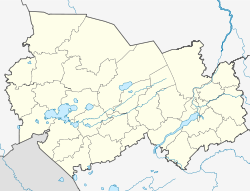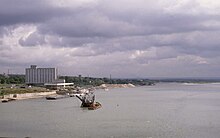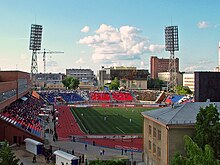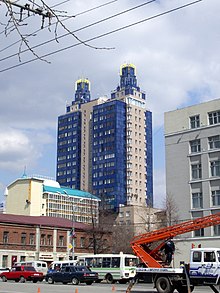Novosibirsk
| city
Novosibirsk
Новосибирск
|
|||||||||||||||||||||||||||||||||||||||||||||||
|
|||||||||||||||||||||||||||||||||||||||||||||||
|
|||||||||||||||||||||||||||||||||||||||||||||||
| List of cities in Russia | |||||||||||||||||||||||||||||||||||||||||||||||
Novosibirsk ( Russian Новосибирск , ) is the third largest city in Russia and the largest city in Siberia after Moscow and Saint Petersburg . The metropolis of Novosibirsk Oblast in Western Siberia has 1.61 million inhabitants (as of 2018). It owes its foundation to the construction of a bridge on the Trans-Siberian Railway over the Ob river in 1893. Today there are six bridges over the Ob in the Novosibirsk area, some of which are almost a kilometer wide. The city has been called Novosibirsk ("New Siberia") since 1926.
geography
The city is located east of the Ural Mountains in the south of the West Siberian lowlands in the time zone UTC + 7 (4 hours before Moscow time ( UTC + 3 )). With the construction of the railway bridge over the Ob, the rise from a small village to a metropolis began.
In what was then Novonikolajewsk, the chapel of St. Nikolai was built in 1915 on the occasion of the 300th anniversary of the Romanov dynasty as a symbol of the geographic center of the Russian Empire . Today the chapel in the center of Novosibirsk is a special attraction and a symbol of the city. However, the geographic center of present-day Russia has shifted to Krasnoyarsk .
history
The history of Novosibirsk is closely related to the development of Western Siberia. The settlement was initially called Novaya Derewnja (New Village), Gussewka , Krivoschtschokowski , Alexandrowski , Novo-Nikolaewski , until it was named Novonikolajewsk (Новониколаевск, after the name of the last Russian tsar ) in 1903 with city rights . In 1926 the city was renamed Novosibirsk.
Alexander III began in the late 19th century with the construction of the Trans-Siberian Railway (1890-1900) to ensure the connection of the Siberian region with its wealth of natural resources to Moscow and western Russia. The connection was supposed to cross the Ob river at the old town of Kolyvan , but plans were changed so that the bridge was built near the small village of Krivoschtschokowo . Since this required a large number of railway workers, a settlement was quickly built on the bridge.
The official founding date is the laying of the foundation stone of the railway bridge over the Ob with a church service on May 20, 1893. In the spring of 1897 the bridge was opened to traffic, the station with infrastructure was already in place. As the surrounding settlements quickly took advantage of this opportunity to transport their goods, the city grew rapidly. Novonikolajewsk already had 7,800 inhabitants at that time.
In December 1903 Novonikolayevsk got official city status. Including the population of the area, it had 22,000 inhabitants. In 1906 the first Siberian bank was founded in Novonikolajewsk; in 1915 there were already five banks. The city quickly became the region's financial and commercial center. In 1907 she was granted all rights of self-government. The population was 47,000. Shortly before the October Revolution , the city had 80,000 inhabitants and was the largest industrial city that was not only industrially developed in the agricultural sector, with more than 40 schools, cinemas, a university, a shipyard and more than 8 churches.
In 1917, during the turmoil of the October Revolution, workers and soldiers took over the city. Novonikolayevsk became an important strategic point for Kolchak's army (500,000 soldiers) in the civil war , but was captured by the Red Army in 1919. The bridge was destroyed and the city suffered from the aftermath of the civil war. Cholera , typhus and other epidemics killed thousands. Novonikolayevsk was one of the few cities in the difficult early days of the USSR where nothing was missing. In 1921, administrative institutions were relocated from Omsk to Novonikolayevsk under Lenin , and the city became the capital of the newly established Novonikolayevsk Governorate , which was only to exist until 1925.
On February 12, 1926, at the request of the residents, the city was renamed Novosibirsk (freely translated "New Siberia"), as it is still called today. Under Stalin , the city became mainly an industrial center. It lost its importance as a trading center. Many of the new industries were focused on the agricultural sector.
From 1925 to 1930 Novosibirsk was the capital of the Siberian Krai and, after its division, the West Siberian Krai until 1937 . Subsequently, the Novosibirsk Oblast , which still exists today, was formed.
During the famine period of 1932–1933, more than 170,000 refugees came to Novosibirsk and settled in slums on the outskirts of the city, which are now large districts. After the German invasion of the Soviet Union in 1941/42, more than 50 industrial manufacturing plants were relocated from western Russia to Novosibirsk, and the city became an armaments center. More than 140,000 refugees stayed in the city temporarily during the war . Between 1915 and 1945, more than 26 military hospitals were built in Novosibirsk.
In Novosibirsk there was a POW camp 199 for German POWs from World War II . Seriously ill people were cared for in the prisoner-of-war hospital in 2,494 . To the west of the Ob there was a cemetery where around 20,000 German and Japanese prisoners of war were buried.
Novosibirsk developed into the main transport hub of Siberia as a connection between West and East. In 1943 the Siberian department of the Academy of Sciences was opened in Novosibirsk. From this point on, Novosibirsk is also the most important educational institution in Siberia. The tram was built in 1954, and Novosibirsk had a population of 287,000. In 1955 the main bridge over the Ob, the "Kommunalni Bridge", was built.
In 1957 the Ob-Reservoir (1070 km² area, maximum 8.8 billion m³ of storage volume) was built for the purpose of generating electricity (1687 million kWh on an annual average). This resulted in further environmental problems in addition to those already caused by strong industrialization. Erosion due to destroyed (flooded) forests, floods and floods occurred.
Akademgorodok , the city of science, was also built on the banks of the Ob reservoir in 1957 (approx. 30 km south of the city center) and became the center of the Siberian department of the Academy of Sciences. 14 research institutions and universities were set up there within a very short time, almost a new city. At the beginning of the 1960s, Novosibirsk reached a size of more than one million inhabitants. The construction of the metro began in 1979 and the first line opened in 1985.
Population development
| year | Residents |
|---|---|
| 1897 | 8,000 |
| 1926 | 120,000 |
| 1939 | 405.297 |
| 1959 | 885.045 |
| 1970 | 1,160,963 |
| 1979 | 1,312,480 |
| 1989 | 1,436,516 |
| 2002 | 1,425,508 |
| 2010 | 1,473,754 |
| 2013 | 1,523,808 |
| 2020 | 1,625,631 |
Note: Census data (1897–1926 rounded)
Culture
Novosibirsk is the cultural center of Siberia and an important location for theater and music in Russia. The cultural life of Novosibirsk takes place in theaters, museums and galleries. Among the theaters, the Academic Opera and Ballet Theater is probably the best known. The professional theaters in Novosibirsk recruit their members from the famous "Glinka", the State Conservatory, the Ballet School and the Novosibirsk Theater School and the Music College. The Academic Symphony Orchestra of the Novosibirsk State Philharmonic, which was founded in January 1, 1937, is also internationally known. Arnold Katz (1924–2007), who was named “Man of the Year” in 1994 and in 1998 received the Russian State Prize, was the orchestra's founder and leader for many years . The new concert hall in Novosibirsk was named after him, the opening concert of which was conducted in 2012 by his successor, the Lithuanian conductor Gintaras Rinkevičius .
Another specialty of Novosibirsk is the violin school, which produced international greats such as Anton Barachovsky , Ilya Konovalov , and Vadim Repin . Vadim Repin is also the initiator of the new “Transsiberian Art Festival” in his hometown, the opening concert of which took place in April 2014 in the new Arnold Katz concert hall under the direction of Kent Nagano .
Performing arts and opera
The city's theaters and artists are regularly awarded the prestigious Russian Golden Mask theater prize. In 2004, for example, the Novosibirsk Opera and Ballet Theater received the Golden Mask for its staging of Alfred Schnittke's opera Life with an Idiot . In 2005 he was again awarded the Golden Masks: the director Dmitri Tschernjakow and the set designer Irina Makarowa for their Aida production. The youth theater Globus received two golden masks in 2004 for the production Doppelte Verführung ("Двойное непостоянство"), for the staging and the leading actress Olga Zink, and in 2005 the music comedy for the play Some like hot with a golden mask excellent. The Tannhauser production by Timofej Kulyabin was included in the list of the ten best premieres in Russia in 2014 by the Kommersant newspaper .
After violent protests, especially from the Orthodox Church, the public prosecutor brought the Tannhäuser production, which had been praised as an example of artistic freedom and a “milestone in the perception of Russian Wagner ”, to court in March 2015 for “deliberate public desecration of religious and liturgical literature and religious cult objects” because in it the eponymous hero when Jesus has fun with half-naked women in the Venus grotto brothel. Although the proceedings were discontinued for lack of evidence, Boris Mesdritsch , the director of the house, was replaced by the St. Petersburg director Vladimir Kechman , who immediately deleted the controversial production from the repertoire of the Novosibirsk Opera and Ballet Theater.
Museums
The Novosibirsk State Art Museum opened on December 27, 1959. Until 1994 it was called the Novosibirsk Regional Picture Gallery. The collection includes around 9,000 works, including those by Nicholas Roerich . The Siberian Center for Contemporary Art opened on September 23, 2010. It is the first state center for contemporary art in Siberia.
There is a local museum in Novosibirsk, as well as a relatively new museum of the history and culture of the peoples of Siberia. Novosibirsk's geological and zoological museums are world famous.
Attractions
The city can boast numerous testimonies of socialist classicism , such as the opera house, the huge Lenin statue placed on its forecourt , the town hall, the Lenin house and many more. The sights of Novosibirsk also include prestigious buildings built at the beginning of the 20th century such as the train station in the center of the city, one of the largest of its kind in Russia, the art gallery, the municipal museum of local history, the officers' house and numerous churches.
The Novosibirsk people see a small chapel, which was considered the center of the Russian Empire, in the center and the first two bridges over the Ob (railway bridge and Kommunalnyi Most) as the most important sights of the city. Tourist attractions are also the restored Alexander Nevsky Cathedral and the large, spacious zoo. The Small West Siberian Railway is a park railway located near the zoo.
The new Roman Catholic Episcopal Church was consecrated in 1997.
There has been a memorial for laboratory mice since 2013 .
economy

Novosibirsk is one of the most important industrial and scientific centers in Russia.
The most important industries are armaments industry, aircraft construction ( Tschkalow-Flugzeugwerke , subsidiary of Sukhoi ), mechanical engineering ("Sibelektrotjaschmasch" plant), agricultural machinery ("Sibselmasch" plant), metal industry (black and non-ferrous metallurgy), electrical engineering and electronics, chemical and pharmaceutical industry, Light and food industry, building materials. The telecommunications company Sibirtelekom was based in Novosibirsk until it was taken over by Rostelekom . In Akademgorodok and Kolzowo attempts are being made to expand the IT industry. Several small and medium-sized software companies develop programs for Russia, Europe and America from here.
The power supply for Novosibirsk is provided, among other things, by the hydropower plants in the area, in particular the hydropower plant of the Ob reservoir . In addition, several coal-fired power plants supply the city with electricity and heat.
Infrastructure
A monitoring station of the SDCM system is located on site .
Local transport
The Novosibirsk Metro , which opened in 1985 and is still being expanded, consists of two lines that cross in the city center and have a total of twelve stations. The tram network has been neglected since the metro opened . Almost all routes in the city center have been closed, the fleet of vehicles and the remaining routes are in poor condition. Since 1992, the nets on the left and right banks are no longer connected. The municipal trolleybus system, which serves almost all city districts, is more important. Here, too, the infrastructure suffers from a lack of investment. The most important mode of transport is bus transport. Almost all municipal lines were handed over to private operators. For the most part, buses of the brands MAZ and LiAZ are used, occasionally Asian buses or vehicles from PAZ . GAZ , Peugeot Boxer and Ford Transit with 14 to 25 seats are mainly used for lines with minibuses (" Marschrutka ") .
The suburbs like Akademgorodok can be reached by buses, minibuses or suburban trains ( Elektritschkas ).
The vehicles of all local transport lines can be tracked online and on mobile phones in real time.
Long-distance transport
Novosibirsk has an international airport ( Tolmachowo ), an inland port , a bus station and is on the Trans-Siberian Railway . Until December 2013, the city could be reached via the Novosibirsk train station without changing trains from Berlin. The city is the administrative seat of the West Siberian Regional Directorate of the Russian State Railways . The directorate not only operates all railway lines and associated infrastructure in the Novosibirsk area, but also a rail network over 9,000 kilometers long. The city airport ( Novosibirsk-Severny airport ), which was last used for flights to the northern taiga , has been closed since February 2011 and is used for urban development.
The city is located on the transcontinental road connection from Moscow to Vladivostok . The Russian trunk road R254 ends here and the R255 begins . At the same time, Novosibirsk is the starting point for the R256 junction , which leads south via Barnaul to Gorno-Altaisk and then south-east through the Altai Mountains to Taschanta on the Mongolian border.
education
In Novosibirsk exist at the present time 24 (with branches of universities from other cities 34) universities , including the Novosibirsk State University , the Novosibirsk State Technical University and the State University of Architecture and Construction Novosibirsk . The large conservatory is also located in Novosibirsk , and here is the seat of the Siberian section of the Academy of Sciences of Russia .
Universities
- Faculty of Moscow State Commercial University
- Branch of Tomsk State University
- Russian-German University
- Siberian State Geodetic Academy
- Siberian State University of Telecommunications and Computer Science
- Siberian State University of Transportation
- Siberian University of Cooperative Studies
- Novosibirsk State Agricultural University
- Novosibirsk State Medical University
- Novosibirsk State Pedagogical University
- Novosibirsk State Technical University
- Novosibirsk State University
- Novosibirsk State University of Architecture and Construction
- Novosibirsk State University of Economics and Administration
- Novosibirsk State University of Architecture, Design and Art
- Siberian State University of Water Transportation
Sports
One of the city's most famous sports clubs is the HK Sibir Novosibirsk ice hockey club , which takes part in the continental hockey league (KHL) . Its home arena is the multi-purpose arena Ice Sports Palace Sibir , which was completed in 1964 and has almost 7,400 seats and is used for concerts as well as for ice hockey games.
In addition, the city was represented by the football club FK Sibir Novosibirsk , which was dissolved in 2019 . In the 2010 season , the team took part in the hosting of the Premjer League . The successor club FK Novosibirsk plays third class .
In volleyball , Novosibirsk is represented by the team from VK Lokomotiv Novosibirsk , which is also successful in the European Cup, so that the volleyball Champions League was won in 2013 , and in the bandy from HK Sibselmasch Novosibirsk , who participates in the game of the Super League . The basketball club BK Novosibirsk represents the city in the Russian Superleague .
sons and daughters of the town


Town twinning
Novosibirsk lists the following twin cities :
-
 Minneapolis , United States (1988)
Minneapolis , United States (1988) -
 Saint Paul , United States (1988)
Saint Paul , United States (1988) -
 Sapporo , Japan (1990)
Sapporo , Japan (1990) -
 Larnaca , Republic of Cyprus (1993)
Larnaca , Republic of Cyprus (1993) -
 Daejeon , South Korea (1995)
Daejeon , South Korea (1995) -
 Mianyang , People's Republic of China (2000)
Mianyang , People's Republic of China (2000) -
 Varna , Bulgaria (2008)
Varna , Bulgaria (2008) -
 Osh , Kyrgyzstan (2009)
Osh , Kyrgyzstan (2009) -
 Kharkiv , Ukraine (2011)
Kharkiv , Ukraine (2011) -
 Minsk , Belarus (2012)
Minsk , Belarus (2012) -
 Shenyang , People's Republic of China (2013)
Shenyang , People's Republic of China (2013) - Sevastopol (2014)
-
 Yerevan , Armenia (2014)
Yerevan , Armenia (2014) -
 Tiraspol , Transnistria (2016)
Tiraspol , Transnistria (2016)
Eponyms
The asteroid (4271) Novosibirsk , discovered on April 3, 1976, was named in 1993 to coincide with the 100th anniversary.
Politics and administration
Novosibirsk is divided into ten urban areas, seven of which are on the right side of the Ob:
- Zentralny ( Центральный , city center)
- Schelesnodoroschny ( Железнодорожный , station district, west of the center)
- Oktyabrsky ( Октябрьский , south of the center)
- Dzerzhinsky ( Дзержинский , east of the center)
- Kalininski ( Калининский , north of the center)
- Sajelzowski ( Zaeltsovsky , north of the center)
- Pervomaiski ( Первомайский , suburb south of the urban area)
To the left of the Ob there are two further districts:
- Leninsky ( Ленинский , northern part with the second city center)
- Kirovsky ( Кировский , southern part)
The Sovetsky Rajon ( Советский ) lies to the left and right of the Ob on the northern bank of the Ob reservoir , about 20 kilometers south of the city proper. The academy city of Akademgorodok is part of the Soviet district. A second scientific center, Krasnoobsk , in which mainly agricultural institutes are based, is located near Novosibirsk, but is not part of the urban area. The Kolzowo settlement - a technology center - does not belong administratively to the city either.
mayor
Mayor of Novosibirsk was from January 2014 to April 2014 Vladimir Snatkow ( Russia ) as a successor to the incumbent since 2000 Vladimir Gorodetsky had, who was appointed vice governor and thus resign. On April 6, 2014, Anatoly Lokot of the Communist Party of the Russian Federation (KPRF) was elected as the new mayor with almost 44 percent of the vote.
Climate table
| Novosibirsk | ||||||||||||||||||||||||||||||||||||||||||||||||
|---|---|---|---|---|---|---|---|---|---|---|---|---|---|---|---|---|---|---|---|---|---|---|---|---|---|---|---|---|---|---|---|---|---|---|---|---|---|---|---|---|---|---|---|---|---|---|---|---|
| Climate diagram | ||||||||||||||||||||||||||||||||||||||||||||||||
| ||||||||||||||||||||||||||||||||||||||||||||||||
|
Average monthly temperatures and precipitation for Novosibirsk
Source:
|
|||||||||||||||||||||||||||||||||||||||||||||||||||||||||||||||||||||||||||||||||||||||||||||||||||||||||||||||||||||||||||||||||||||||||||||||||||||||||||||||||||||
Web links
- Official website of the city
- Further information on history, leisure activities and sights (created by Germans in Novosibirsk)
Individual evidence
- ↑ Itogi Vserossijskoj perepisi naselenija 2010 goda. Tom 1. Čislennostʹ i razmeščenie naselenija (Results of the All-Russian Census 2010. Volume 1. Number and distribution of the population). Tables 5 , pp. 12-209; 11 , pp. 312–979 (download from the website of the Federal Service for State Statistics of the Russian Federation)
- ↑ Russia - Biggest Cities 2018. Accessed December 1, 2019 .
- ↑ www.olympia-reisen.ru: ( Memento from August 19, 2009 in the Internet Archive ) "Novosibirsk"
- ↑ История. In: Официальный сайт города Новосибирска. Archived from the original on August 19, 2009 ; Retrieved December 3, 2010 (Russian).
- ↑ Maschke, Erich (ed.): On the history of the German prisoners of war of the Second World War. Verlag Ernst and Werner Gieseking, Bielefeld 1962–1977.
- ↑ Bayerischer Rundfunk Klassik, Biographie ( memento of November 13, 2012 in the Internet Archive ), accessed on April 1, 2015
- ^ "Music in a State of Emergency " - Israel, DIE ZEIT, July 30, 2009 , accessed April 1, 2015
- ↑ Interview with Nagano, FOCUS online from April 10, 2014 , accessed on April 1, 2015
- ↑ Jekaterina Sinelschtschikowa in Russia beyond the Headlines of March 12, 2015 ( memento of April 1, 2015 in the web archive archive.today ), accessed on April 1, 2015
- ^ "Tannhauser" in Novosibirsk. Attack on Wagner , FAZ March 30, 2015 , accessed on April 1, 2015
- ↑ Bayerischer Rundfunk Klassik, March 31, 2015 ( Memento from April 2, 2015 in the Internet Archive )
- ↑ Die Welt , accessed April 1, 2015
- ↑ Городской транспорт Новосибирска. МУ "ЦУГАЭТ". nskgortrans.ru, accessed October 10, 2013 .
- ↑ Novosibirsk State University of Architecture, Design and Art. Retrieved April 8, 2018 (Russian).
- ^ Siberian State University of Water Transportation. Retrieved April 8, 2018 (Russian).
- ↑ MPC
- ^ Wiener Zeitung: KP wins mayoral election in Novosibirsk on April 7, 2014
- ↑ Roshydromet
- ↑ wetterkontor.de














